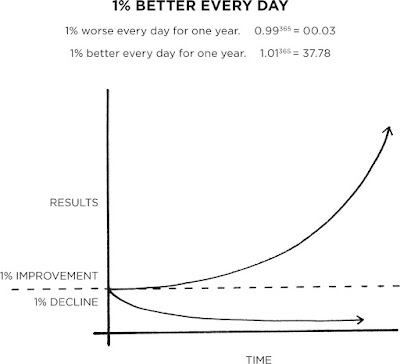![Atomic Habits: The life-changing million copy bestseller by [James Clear]](https://m.media-amazon.com/images/I/51-nXsSRfZL.jpg)
Atomic
Habits:
About
the Author: James clear is the Author
of international bestselling book Atomic Habits, Creator of jamesclear website, A Speaker who delivers couple of speeches per month in events and
companies like: Lululemon, McKinsey & Company, Merrill Lynch, and many more
and He is also a Weight Lifter and
Former Athlete in his college life.
It is easy to overestimate the
importance of one defining moment and underestimate the value of making small
improvements on daily basis. We convince our self that we need massive success requires
massive actions. Whether it is losing weight or achieving any other goal we
mainly focus on improvement that will shock everyone around us and resulting
they will talk about it, mainly we focus on what to do so that everyone will
talk about me. Meanwhile 1% improvement is not noticeable but it meaningful in
long run. The difference a tiny improvement can make over time is magnificent.
If you are getting better 1 percent each day at the end of year you will be 36
percent better which is phenomenal change which is unachievable by 70 percent
of the people who sets their New year resolutions each year and failed after a
week or two. Conversely, if you are getting 1 percent each day then at the end
of year you will be nearly down to zero.
The Habit is compound interest of self-improvement same as money which is multiplies through compound interest; the effects of your habits multiply as you repeat them. Changes will not be visible on any given day but the impact they deliver over the month will be tremendously
enormous.
We generally ignore small changes and say they don’t seem to matter very much in
that moment but if you save a little money now you are still not the
millionaire but if you continues to save for time you can be one, If you go to
gym 3 days on a row you are still out of shape but if you continues to do so
and maintain a proper diet and routine you will get the results that you have
desired. We make few changes but a result never seems to come so we get back to
previous routine again.
Breakthrough moment is often the result
of any previous actions which is building up the potential required to unleash
the major change. As depicted in book, Imagine if you are in a room with an ice
cube on the table in front of you. It is currently 25 degrees and temperature is
being increased slowly and room is being heat up.
“Twenty-Six
degrees”
“Twenty-Seven
degrees”
“Twenty-Eight
degrees”
“Twenty-Nine
degrees”
“Thirty
degrees”
“Thirty
one”
nothing happened till now, then “Thirty two degree” is reached ice-cube starts to melt. A one degree shift may not be noticeable but the potential to melt that ice-cube was being formed from “Twenty Five degrees” which is called as breakthrough moment and as per James it is “Plateau of Latent Potential”.
“Outcomes
are about what you get. Processes are about what you do. Identity is about what
you believe.”
“With
outcome-based habits, the focus is on what you want to achieve. With
identity-based habits, the focus is on who you wish to become.”
“The
ultimate form of intrinsic motivation is when a habit becomes part of your
identity.”
We
can change our habits by asking some questions to our-self,
How
can I make it obvious?
How
can I make it attractive?
How
can I make it easy?
How
can I make it satisfying?
Any
habit can be broken down into a feedback loop that involves four steps: cue,
craving, response, and reward.
If
you want to change your habit by auditing youself by asking if this habit will
be helpful to become the type of person I want to become?
The
best way to start a new habit is the stack your new habits in between those habits
that you are doing daily. This is called as habit stacking.
One of the most practical way to eliminate a bad habit is to reduce exposure to the queue that causes it.
The
second law of behavior change is make it attractive, the more likely the opportunity
is more likely it will be habit forming.
We
tend to imitate habits mostly from three social groups: the close (family and
friends), the many (the tribe), and the powerful (those with status and
prestige). One of the most effective things you
can do to build better habits is to join a culture where (1) your desired behavior
is the normal behavior and (2) you already have something in common with the
group.
The
upside of habits is that we can do things without thinking. The downside is
that we stop paying attention to little errors.
Click to get kindle edition: https://amzn.to/2ZtVJLG
Click to get hard cover edition : https://amzn.to/3bYI0iC




Comments
Post a Comment